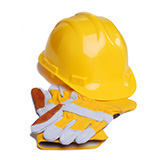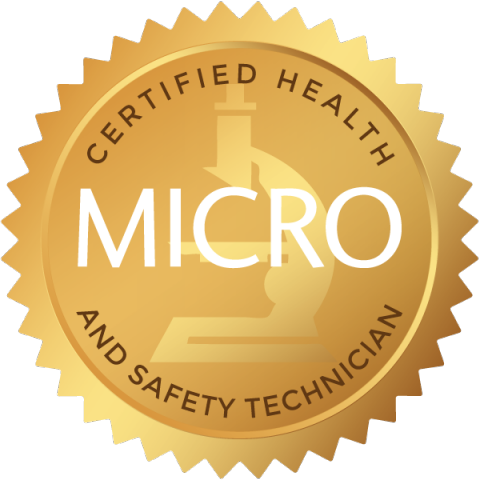This course provides required health and safety awareness training for anyone performing restoration or mold remediation. This course is designed to reduce risks and improve safety on the job by providing learners with a good understanding of the key OSHA-mandated health and safety training topics related to restoration and mold remediation.
This exciting and timely online certificate program could be exactly what you need to build an awareness of safety in your organization. Earn this certification with approximately 20 online hours of specific safety training each with quizzes, and make safety an integral part of your business. This comprehensive program includes the following online courses:
Asbestos Hazard Awareness:
- This awareness-level course is for people who work in areas with asbestos-containing material or presumed asbestos-containing material and need to know how to avoid disturbing it. High-risk activities such as mining asbestos, manufacturing asbestos-containing material and remediation of asbestos or removal of asbestos-containing material require extensive additional training. When learners have competed this course, they should be able to identify the basics of asbestos and identify standard exposure control measures.
Basic First Aid:
- Emergencies can happen any time, any place. This course will teach employees the basics of first aid procedures and how to apply them to real-world scenarios. Employees will learn how to identify the steps for conducting basic first aid. They will also learn how to recognize the symptoms and procedures for common first aid situations. This course is presented in English, Spanish, Bosnian, German, Portuguese, Polish, and Mandarin.
Bloodborne Pathogens:
- When learners have completed this course, they should be able to recognize the basics of bloodborne pathogens and identify the meaning and risks of occupational exposure. They should also be able to identify how to safely handle sharps and contaminated waste.
Cold Stress In The Workplace:
- People who work outdoors or in cold indoor environments are frequently subject to cold, wet working conditions. Working in wet or cold environments can take a heavy toll on worker's bodies and be hazardous to their health. Workers who work in wet in cold or wet environments must be able to prepare to work in these conditions. Learners who successfully complete this course should be able to identify factors that contribute to cold stress, recognize signs and symptoms of cold stress, and identify controls that can help prevent cold stress. This course is presented in English and Spanish.
Confined Space Awareness:
- Confined spaces are some of the most hazardous work environments. This course will teach employees the hazards and safety precautions associated with confined spaces, with a heavy emphasis on OSHA safety requirements. Employees will learn how to identify confined spaces, their hazards, methods used to control those hazards and the regulations regarding `permit-required' confined spaces. This course is intended for general industry employees who are required to work in or around areas defined by OSHA as confined spaces. This course is designed to help employers meet OSHA's standards on permit-required confined spaces. This course is presented in English, Spanish, Bosnian Polish.
Environmental Awareness:
- Learners who successfully complete this course should be able to recognize signs and sources of land, water, and air pollution, the effects pollution has on the environment, and how to protect their communities from environmental harm.
Hazard Communication:
- People who successfully complete this course should be able to recognize the purpose and requirements of a hazard communication, or HAZCOM program, and identify chemical hazards and their controls in their workplace. They should also be able to identify sources of information for workplace chemical hazards and requirements for medical recordkeeping. This course is presented in English, Bosnian German, Polish, Portuguese and Spanish.
Hazard Materials Classification - Basic:
- Hazardous materials are used in manufacturing, service industries and many other applications. To protect the people who transport these substances and the public at large, the U.S. Department of Transportation (DOT) has created a hazardous materials classification system. Learners who successfully complete this course will demonstrate knowledge of how to identify general definitions related to the DOT's hazardous materials classification. This course is designed for workers that, during the execution of any job duties, are required to work with or around hazardous materials. This course is presented in both English and Spanish.
Heat Stress In The Workplace:
- Working in high heat can cause a number of health issues, particularly for workers who are not acclimated to the conditions. This course will teach employees the hazards of working in high heat and how to minimize or eliminate those hazards. Employees will learn how to identify the hazardous health effects of high heat, methods to prevent those health effects and what to do if a co-worker exhibits symptoms of heat stress such as heat fatigue, heat rash, heat cramps, heat exhaustion and heat stroke. This course is intended for people who, during the course of regular work duties, are exposed to high-temperature conditions for significant periods of time. This course is presented in English and Spanish.
Incident Investigation:
- In a perfect world, there would be no workplace accidents. Unfortunately in the real world injuries, property damage, work disruption and near miss incidents will happen from time to time. When they do, it is important to have a procedure in place to determine what happened, how and why it happened, and how to prevent it from happening again. Learners who successfully complete this course should be able to identify aspects of an incident investigation. This course is available in English and Spanish.
Indoor Air Quality:
- Most of us take it for granted that wherever we go, the air will be safe and breathable. But air quality isn't a guarantee. Air quality can get bad anywhere, including inside an office building, based on factors such as how many people are in a workspace and how well the building is maintained, among others. This course will teach employees about the importance of indoor air quality, how it can become a hazard and what they can do to prevent poor air quality in the workplace. Employees will learn how to identify air contaminant types and their sources and good habits for keeping the air clean and breathable. This course is presented in both English and Spanish.
Lead Awareness:
- Accidental exposure to and consumption of lead is poisonous and can result in significant organ and tissue damage. This course will teach employees about the hazards of lead exposure and controls used to minimize or eliminate those hazards. Employees will learn about the effects of lead exposure and the use of personal protective equipment and other methods to reduce the risk of hazardous exposure. This course is intended for general-industry employees who may be exposed to significant levels of lead, and can assist employers in meeting OSHA's requirements on lead exposure. This course is presented in English and Spanish.
Personal Protective Equipment:
- Personal protective equipment, or PPE, has been around throughout history in various forms. Even everyday clothing is a form of PPE, but many jobs and workplaces have hazards that require additional protection, such as gloves, boots, and goggles. After completing this course, the learner should be able to identify common types of PPE and their uses, as well as OSHA's requirements for PPE. The learner should also be able to identify employee and employer responsibilities for selecting, using, and maintaining PPE. This course is presented in English, Spanish, Bosnian, German, Portuguese, Korean, Mandarin, European French, and Polish.
Personal Protective Equipment: Eye and Face Protection:
- After completing this course, employees should be able to recognize the various types of eye and face PPE and their uses. This course addresses a specific aspect of a broader training topic, Personal Protective Equipment.
Respiratory Protection:
- Many work environments can involve airborne particles that could be hazardous if inhaled. Airborne viruses, hazardous chemical fumes, and even some types of dust particles can cause injury or illness if workers breathe them in. Learners who successfully complete this course will demonstrate knowledge of the basics of respiratory protection and how to use it on the job. Employees will learn about potential inhalation hazards, the different respirator types and their uses, how to fit test a respirator mask, and respirator care and maintenance. This course is designed for general industry employees who, during their regular work duties, are required to wear respiratory protection, and is intended to assist the employer in meeting OSHA's Respiratory Protection Standard. While this course addresses OSHA training requirements, there may be additional site-specific training components, hands-on training, and health testing required that must be fulfilled by an employer. This course is presented in English, German, and Spanish.


